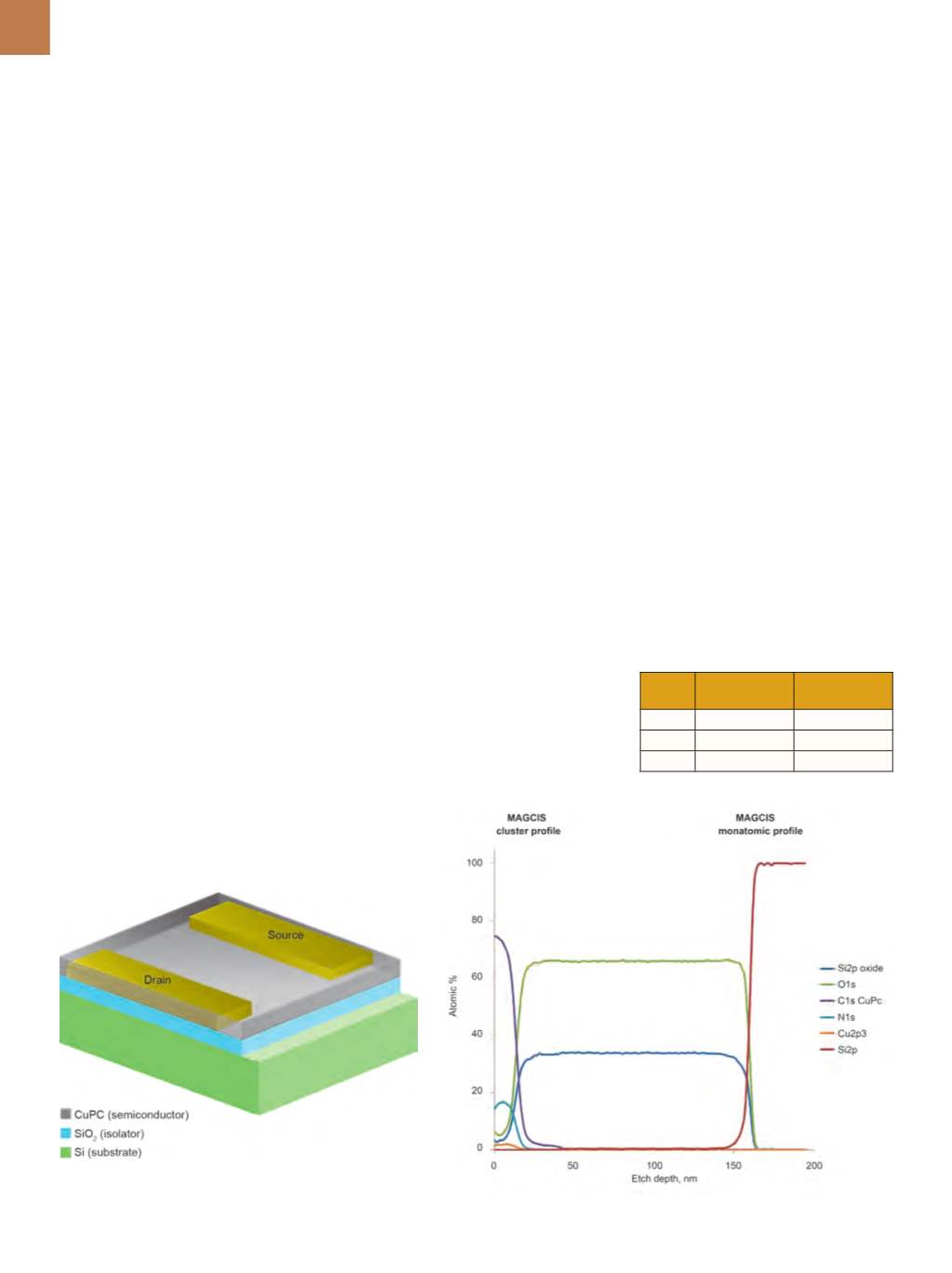

A D V A N C E D M A T E R I A L S & P R O C E S S E S | S E P T E M B E R 2 0 1 5
3 0
performance. Copper phthalocyanine
(CuPc) is of significant interest as an or-
ganometallic semiconductor and is the
basis for the device under study.
Using a depth profiling technique,
XPS can monitor the composition of
a coated or layered material to great-
er depths (hundreds of nm or even µm
scales). Traditional ion sputtering depth
profiling techniques cause significant
damage to the subsurface of “soft” or-
ganic materials, which is visible in XPS
data as a loss of structure and chemical
information. The new MAGCIS source
addresses this problem. The gentle,
shallow sputtering from argon cluster
ions does not cause subsurface damage,
so XPS data preserve chemical state in-
formation throughout the entire profile.
MAGCIS can also generate traditional
monatomic ion beams for profiling in-
organic materials, so it is possible to
profile through an organic layer with the
cluster ions, then switch to monatomic
ions to profile into a harder substrate.
The K-Alpha
+
XPS instrument, fit-
ted with the MAGCIS cluster ion source,
was used to acquire depth profiles from
the CuPc FET, and was profiled with
4 keV argon cluster ions, with an aver-
age cluster size of 2000. The source was
then switched to monatomic ion gener-
ation to profile through the SiO
2
isola-
tion layer into the silicon substrate. The
two profiles were combined to produce
a single depth profile through the entire
organometallic/inorganic stack.
In this analysis, the spectra are
similar, but the device sample has more
hydrocarbon signal from surface con-
taminants at 285 eV. This confirms that
the surface chemistry of the organic
layer approximates CuPc. MAGCIS clus-
ter ion sputtering successfully removed
material without causing subsurface
damage, so the XPS spectrum resem-
bles a pure material. This is a primary
strength of the cluster ion technique,
which allows depth profile analysis of
organic materials without visible dam-
age in XPS data. The spectral quantifi-
cation in Table 1 confirms that the ex-
posed CuPc is an excellent match to the
expected composition.
By sputtering through the CuPc
with cluster ions, and through the SiO
2
with monatomic ions, building up a
profile of the entire device stack is pos-
sible (Fig. 2).
CLEANING METAL OXIDES
The benefits of cluster ion sources
are not limited to depth profiling exper-
iments; they can also be useful for more
routine analysis. For example, accu-
rately quantifying the chemical compo-
sitions of metal oxide samples with XPS
can be hindered by adventitious car-
bon contamination, typically present
on the surface. Gas cluster ions do not
penetrate the oxide surface, preserving
chemical state information while still
cleaning contamination from a sample.
With the ability to provide both cluster
ions and monatomic ions, the MAGCIS
source offers versatility and conve-
nience for a range of sample types.
The K-Alpha
+
XPS instrument was
used to acquire spectra froma sample of
tantalumpentoxide. Spectra were taken
at three different areas following differ-
ent cleaning processes. In the first area,
spectra were taken in an as-received
state with no cleaning performed; in
the second position, the sample was
sputtered with 200-eV monatomic ions
before analysis; and at the third posi-
tion, the sample was analyzed following
sputtering with single-ion argon clus-
ters. For this experiment, cluster beam
energy was 4 keV with a cluster size of
1000 atoms. Survey spectra (wide scans
covering the entire elemental range)
were also collected from uncleansed
areas, as well as the area that had been
sputtered with the cluster ion beam.
Fig. 1 —
Schematic of copper phthalocyanine (CuPc)
organic FET.
TABLE 1 —QUANTIFICATION OF
MAGCIS-CLEANED CuPc
Expected
atomic %
Observed
atomic %
C
78.0
78.6
N
19.5
19.4
Cu
2.4
1.9
Fig. 2 —
MAGCIS profile of organic FET.


















